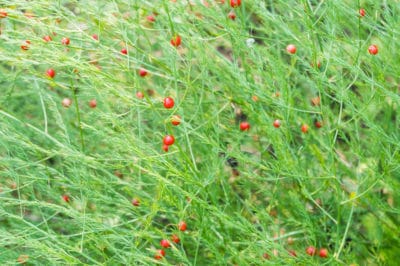Asparagus Seed Pods Look Like Berries
The bright red berries growing on female, and occasionally male, asparagus plants are actually tiny seed pods. Seed pods develop from flowers, appearing first as tiny, green clusters, and then turning into into attractive, cherry-red seed pods.
Male asparagus plants sometimes also produce berries on hermaphroditic flowers. Seeds inside these male-produced pods are 75 percent more likely to produce male offspring, including super-male plants which result in all-male hybrids, the most productive garden vegetable cultivars.
Toxicity of Asparagus Berries
The seed pods of asparagus plants are toxic for humans and also for dogs and cats, producing an allergic reaction in some individuals. Eating the berries can cause vomiting and abdominal pain. Raw asparagus shoots are also mildly toxic, although the toxicity is quickly eliminated by cooking. Allergic response often includes a skin rash, and some people develop contact dermatitis from touching the plants.
Uses for Asparagus Berries
While asparagus berries should not be eaten, the delicate, fern-like green foliage and red berries make an eye-catching background in a bouquet of flowers. The flower of asparagus, although small, also makes a pleasing addition to floral arrangements.
You can collect, dry, and then harvested the seeds from asparagus berries and then use them to start more asparagus plants. To save seeds from asparagus, collect the berries and then:
- Set them on a plate or paper towel until they are completely dry.
- Rub the berries between your hands to remove the papery skin.
- Store in an envelope or paper bag in a cool, dry area.
- Plant in the spring when soil temperatures are above 50ºF (10ºC).
Seeds take up to four weeks to germinate and should grow a total of approximately 12 weeks before transplanting seedlingsinto the garden.
Growing Asparagus Berries
Seedlings can be planted into the garden in 12 weeks, or they can be tended for another year and planted when one year old. When planted out young, the seedlings take an additional year to begin producing edible shoots.
Transplant the seedlings into the garden in late fall or spring, depending on your location, and keep the young plants free from weed competition. The plants will grow in size each year until the third or fourth year when they reach their final size of 4 to 6 feet (1.2 to 1.8 meters).
